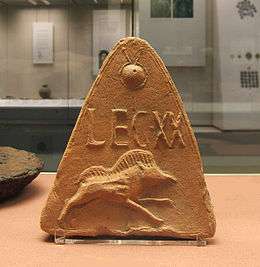Legio XX Valeria Victrix



Legio vigesima Valeria Victrix, in English Twentieth Victorious Valeria Legion was a legion of the Imperial Roman army.
The origin of the Legion's name is unclear and there are various theories, but the legion may have gained its title Valeria Victrix from a victory it achieved during the Great Illyrian revolt under the command of the general Marcus Valerius Messalla Messallinus.
The legion had a boar as its emblem.
History
The legion was probably founded shortly after 31 BC by the emperor Augustus. [1]
XX Valeria victrix was probably part of the large Roman force that fought in the Cantabrian Wars in Hispania from 25 to 19 BC.
The legion then moved to Burnum in Illyricum at the beginning of the Pannonian uprising (Bellum Batonianum) in AD 6.[2] It is recorded operating against the Marcomanni in AD 6 in the army of Tiberius.
In Illyria they were led by the governor of Illyricum, Marcus Valerius Messalla Messallinus, who may have given his clan (gens) name Valeria to the legion. Although understrength, they managed to defeat the rebels led by Bato of the Daesitiates.[3] In one battle the legion cut through the enemy lines, was surrounded, and cut its way out again.
After the disaster of Varus in AD 9, XX Valeria Victrix moved to Germania Inferior and was based at Oppidum Ubiorum, then moved to Novaesium at the site of modern Neuss during Tiberius' reign.
The legion was one of the four with which Claudius invaded Britain in 43 AD. It was also one of the two legions that defeated Caratacus at the Battle of Caer Caradoc, after which, from the AD 50s, it was encamped at Camulodunum, with a few units at Kingsholm in Gloucester.
Around AD 55 it moved to Usk, for the conquest of the Silures, a tribe very resistant to the imposition of Roman rule in Wales.[4] In AD 66, the legion was transferred to Viroconium (Wroxeter).[5] In AD 60 or 61 the XX helped put down the revolt of queen Boudica, after having routed the Ordovices by crossing Menai Strait in Wales to destroy the Druids' sacred groves in 58.[6][7]
.jpg)
The legion was afterwards based at Deva Victrix (Chester).
In the year of the four emperors, the legion sided with Vitellius. Some units went with him to Rome. In AD 78–84, the legion was part of Gnaeus Julius Agricola's campaigns in northern Britannia and Caledonia, and built the base at Inchtuthill. In AD 88 the legion returned south and occupied Castra Deva (Deva Victrix), where it remained based for at least two centuries.
The Twentieth was among the legions involved with the construction of Hadrian's Wall, and the discovery of stone altars commemorating their work in Caledonia suggests that they had some role in building the Antonine Wall.
The legion probably went on campaign in 196 under Decimus Clodius Albinus into Gaul, and would have suffered heavy losses in Gaul before returning to Britain.[8]
During the Carausian Revolt, which established the Britannic Empire under Carausius and Allectus in the 280s and 290s, the XX Valeria Victrix was still active. No further information is known after this period and scholars believe the XX legion was still stationed in Britain when the usurper Constantine III pulled the bulk of the military forces from there in the year 407 for his doomed campaign on the continent.
This legion has been much studied; at least 250 members of the legion have been identified in surviving inscriptions.
Fiction
Legio XX Valeria Victrix and their final days in Deva (Chester) in the early AD 400s form the backdrop to the Tom Stevens mythic-fiction genre novel The Cauldron (special edition)[9] with the story's protagonist Valerian—the Praefectus and Chief Centurion—defending the city with the rump of the legion against the incursions of Hibernian pirates as the "Dark Ages" settle on Britannia.[10] The movie Victrix! The Valiant of Albion is in production and features an adaptation of Tom Stevens novel.
Legio XX Valeria Victrix was the legion featured in the novel Eagle in the Snow; author Wallace Breem postulates that they were annihilated by the Germanic invasion of 406.
Several of the main characters in the early novels of Jack Whyte's A Dream of Eagles series were former members of Legio XX Valeria Victrix.
Gaius Petreius Ruso, protagonist of Medicus by Ruth Downie, is a military doctor in Britannia attached to Legio XX.
Legio XX Valeria Victrix lends its name to the character Valeria Matuchek in Poul Anderson's Operation Chaos and its sequel Operation Luna; her mother is said to describe this legion as the last to leave Britain—"the last that stood against Chaos".
The first person narrator of Stephen Vincent Benét's short story "The Last of the Legions" is the senior centurion of the Valeria Victrix, who recounts the events and the impressions of soldiers and populace surrounding the departure of the legion from Britain.
Legion Company of the U.S. Army's 1st battalion 503rd Infantry Regiment 173rd Airborne Brigade stationed in Vicenza, Italy is named after Legio XX. They chose this name for the paratroopers' ability to fight fiercely behind enemy lines.
Legio XX Valeria Victrix features in the six novel series "Soldier of Rome - The Artorian Chronicles" by James Mace
References
- ↑ http://www.livius.org/articles/legion/legio-xx-valeria-victrix/
- ↑ Velleius Paterculus, Compendium of Roman History, 2.112.1-2.
- ↑ Velleius Paterculus, 2.112.1-2, Cassius Dio, 55.30.1-5.
- ↑ https://museum.wales/articles/2007-05-10/Roman-fortress-discovered-underneath-town-centre/
- ↑ W. H. Manning (2000). "The fortresses of Legio XX". In RJ Brewer (ed.) Roman Fortresses and Their Legions.
- ↑ Moffat, Alistair (2005). Before Scotland. Thames & Hudson. pp. 243–245. ISBN 978-0-500-05133-7.
- ↑ Agricola
- ↑ Mason (2001), pp. 155–156.
- ↑ (special edition) ISBN 978-0-9559656-1-6
- ↑ http://www.amazon.com/dp/0955965616
External links
- livius.org account of XX Valeria Victrix
- LEGIO XX, Maryland (USA) re-enactment group
